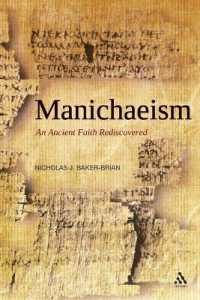- ホーム
- > 洋書
- > 英文書
- > Business / Economics
基本説明
Based on extensive archive research, Mourlon-Druol highlights two long-term processes in the monetary and economic negotiations in the decade leading up to the founding of the EMS in 1979.
Full Description
A Europe Made of Money is a new history of the making of the European Monetary System (EMS), based on extensive archive research. Emmanuel Mourlon-Druol highlights two long-term processes in the monetary and economic negotiations in the decade leading up to the founding of the EMS in 1979. The first is a transnational learning process involving a powerful, networked European monetary elite that shaped a habit of cooperation among technocrats. The second stresses the importance of the European Council, which held regular meetings between heads of government beginning in 1974, giving EEC legitimacy to monetary initiatives that had previously involved semisecret and bilateral negotiations. The interaction of these two features changed the EMS from a fairly trivial piece of administrative business to a tremendously important political agreement.
The inception of the EMS was greeted as one of the landmark achievements of regional cooperation, a major leap forward in the creation of a unified Europe. Yet Mourlon-Druol's account stresses that the EMS is much more than a success story of financial cooperation. The technical suggestions made by its architects reveal how state elites conceptualized the larger project of integration. And their monetary policy became a marker for the conception of European identity. The unveiling of the EMS, Mourlon-Druol concludes, represented the convergence of material interests and symbolic, identity-based concerns.
Contents
Introduction: Multilevel Governance, History, and Monetary Cooperation
1. European Monetary Cooperation, 1945-1974: Background and Debates
2. Shifting Away from the Werner Approach, May 1974-May 1975
3. EMU off the Agenda? June 1975-June 1976
4. Economic Rapprochement, Monetary Standstill, July 1976-June 1977
5. Conflicting Options, July 1977-March 1978
6. A Semisecret Negotiation, Late March-Mid-July 1978
7. Chasing the Ghosts of Failed Negotiations, Mid-July-Late September 1978
8. A False Start, October 1978-March 1979
Conclusions: The Emergence of a European BlocAcknowledgments
A Note on Sources Cited in the Notes
Notes
Sources
Index
-

- 電子書籍
- 婚活ブラックコンシェルジュ 束 愛子~…
-

- 電子書籍
- 毒殺される悪役令嬢ですが、いつの間にか…

![»Dieses widerliche Gemetzel«. Über das Leid der Tiere und den Vegetarismus. [Was bedeutet das alles?] : Voltaire - Erläuterungen; Denkanstöße; Analyse - 14075 (Reclams Universal-Bibliothek 14075) (2023. 80 S. 148 mm)](../images/goods/ar/work/imgdatak/31501/3150140757.jpg)




